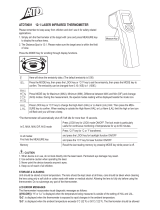
DWYER INSTRUMENTS, INC.
Phone: 219/879-8000 www.dwyer-inst.com
P
.O.
BOX 373
•
MICHIGAN CITY
,
INDIANA
46360,
U.S.A.
Fax: 219/872-9057
e-mail:
[email protected]Function:
Press the “MODE” key for scrolling to display more functions as follows.
E: Will show the emissivity data.
MAX, MIN DIF, AVG: Press “MODE” key for the Maximum (MAX),
Difference between MAX and MIN (DIF) and Average (AVG) modes.
During the measurement, the special modes reading will be displayed
beside the mode icon.
HAL, LAL: Press “UP” key or “DOWN” key to change the High Alarm
(HAL) or Lo Alarm (LAL) then press “MEAS” key to confirm it.
PRB: Connect the thermocouple to the thermocouple socket and put the
probe in/on the target to be measured, the thermometer will display the
temperature automatically without pressing any button. To see the
minimum or maximum data during the probe measurement, please hold
down the “UP” key or “DOWN” key.
After measuring high temperatures the probe may remain HOT for a
while.
LED Error Messages
The thermometer incorporates visual diagnostic messages as follows.
“HI/LOW”: “Hi” or “Lo” is displayed when the temperature being
measured is outside of the settings of HAL and LAL.
“Er2”: Displays when the thermometer is exposed to rapid changes in
the ambient temperature.
“Er3”: Displays when the ambient temperature exceeds 32°F (0°C) or
122°F (50°C). The thermometer should be allowed plenty of time
(minimum 30 minutes) to stabilized to the working/room temperature.
For all other error messages it is necessary to reset the thermometer. To
reset it, turn the instrument off, remove the battery and wait for a
minimum of one minute, reinsert the battery and turn it on. If the error
message remains please contact the Dwyer Customer Service
department for further assistance.
Batteries:
The thermometer incorporates visual low battery indication as follows.
Battery OK: Measurements are possible.
Battery Low: Battery needs to be replaced, measurements are still
possible.
Battery Exhausted: Measurements are not possible. When the low
battery icon indicates the battery is low, the batteries should be replaced
immediately with AAA, 1.5V batteries.
Please Note: It is important to turn the thermometer off before replacing
the battery otherwise the thermometer may malfunction. Dispose of used
battery promptly and keep away from children.
CAUTION
1. When device is in use, do not look directly into the laser
beam - Permanent eye damage may result.
2. Use extreme caution when operating the laser.
3. Never point the device towards anyone’s eyes.
4. Keep out of reach of all children.
EMC/RFI
Readings may be affected if the unit is operated within radio frequency
electromagnetic field strength of approximately 3 volts per meter, but the
performance of the instrument will not be permanently affected. **Note:
under the electromagnetic field of 3V/m from 350 to 550 MHz, the
maximum error is 14.4˚F (8˚C).
MAINTENANCE
A periodic check of the system calibration is recommended. The Series
IR4 is not field serviceable and should be returned if repair is needed
(field repair should not be attempted and may void warranty). Be sure to
include a brief description of the problem plus any relevant application
notes. Contact customer service to receive a return goods authorization
number before shipping.
Storage and Cleaning
The sensor lens is the most delicate part of the thermometer. The lens
should be kept clean at all times, care should be taken when cleaning the
lens using only a soft cloth or cotton swab with water or medical alcohol.
Allowing the lens to fully dry before using the thermometer. Do not
submerge any part of the thermometer. The thermometer should be
stored at room temperature between -4 and 149ºF (-20 to 65ºC).
page 2
©Copyright 2014 Dwyer Instruments, Inc. Printed in U.S.A. 5/14 FR # R7-443521-00 Rev. 1



